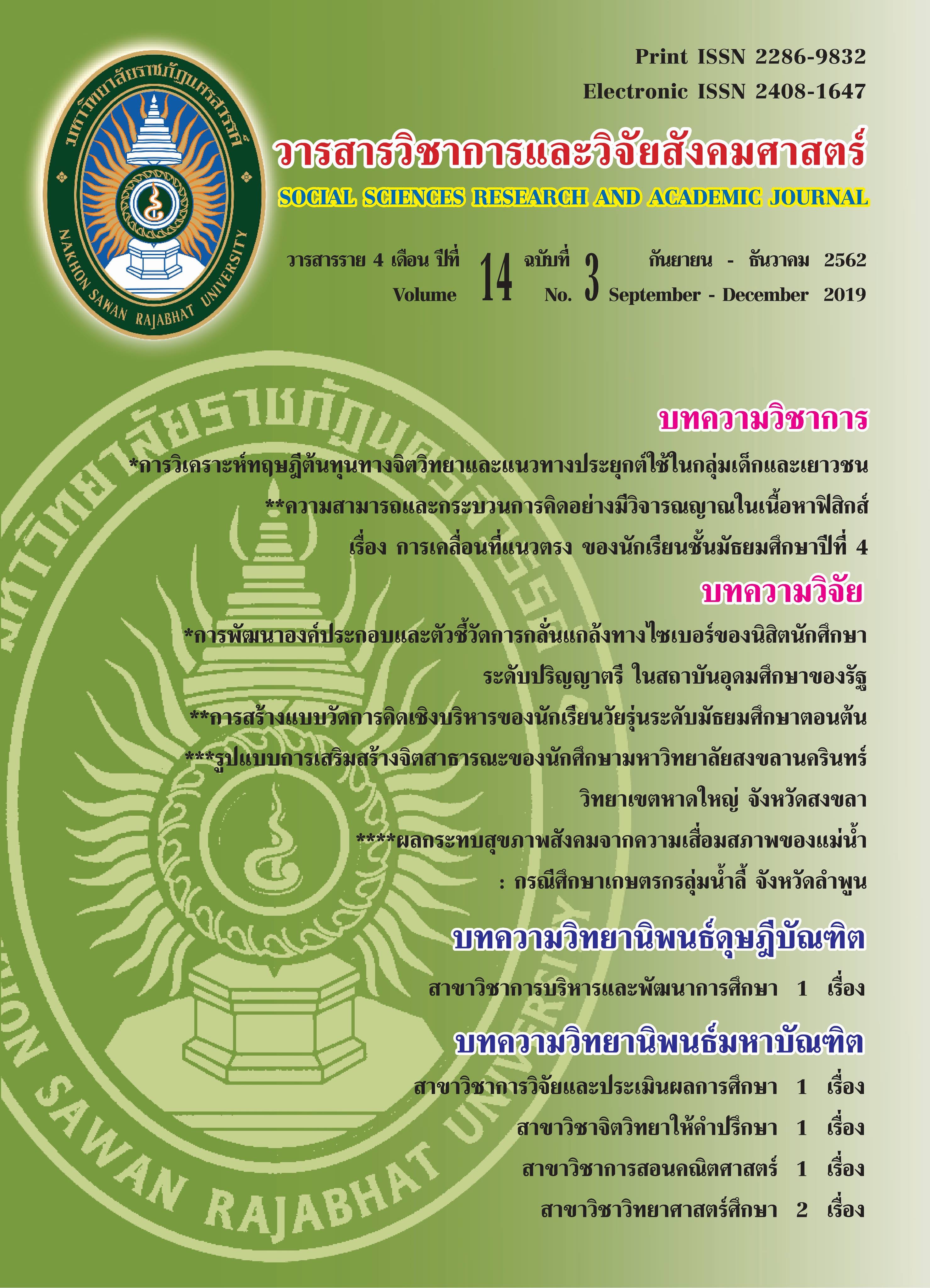การสร้างแบบวัดการคิดเชิงบริหารของนักเรียนวัยรุ่นระดับมัธยมศึกษาตอนต้น A Construction of Executive Function Inventory for Adolescent Students of Junior High School Level
Main Article Content
Abstract
การวิจัยครั้งนี้มีวัตถุประสงค์เพื่อสร้างและตรวจสอบคุณภาพของแบบวัดการคิดเชิงบริหาร รวมทั้งสร้างเกณฑ์ปกติของการคิดเชิงบริหารของนักเรียนวัยรุ่นระดับมัธยมศึกษาตอนต้น กลุ่มตัวอย่างคือนักเรียนชั้นมัธยมศึกษาปีที่ 1-3 ประจำภาคเรียนที่ 1 ปีการศึกษา 2561 ในโรงเรียนสังกัดสำนักงานคณะกรรมการการศึกษาขั้นพื้นฐานทั้ง 6 ภูมิภาคและกรุงเทพมหานคร ซึ่งได้มาจากการสุ่มแบบหลายขั้นตอน จำแนกเป็น 2 กลุ่ม คือ 1) กลุ่มตัวอย่างสำหรับนำเครื่องมือไปทดลองใช้มีจำนวน 202 คน และวิเคราะห์องค์ประกอบเชิงยืนยันของโมเดลการวัดการคิดเชิงบริหารของนักเรียนวัยรุ่นมีจำนวน 800 คน และ 2) กลุ่มตัวอย่างสำหรับสร้างเกณฑ์ปกติมีจำนวน 4,459 คน เครื่องมือที่ใช้ในการวิจัย ได้แก่ แบบสัมภาษณ์กึ่งโครงสร้างและแบบวัดการคิดเชิงบริหารของนักเรียนวัยรุ่นฉบับมัธยมศึกษาตอนต้น สถิติที่ใช้ในการวิจัย ได้แก่ การหาค่าความเที่ยงตรง ค่าอำนาจจำแนก ค่าความเชื่อมั่น การวิเคราะห์องค์ประกอบเชิงยืนยัน และการหาเกณฑ์ปกติ โดยการหาค่าคะแนนมาตรฐาน Normalized T-Score
ผลการวิจัยพบว่า 1) นิยามการคิดเชิงบริหารของนักเรียนวัยรุ่นระดับมัธยมศึกษาตอนต้นประกอบด้วย 3 องค์ประกอบหลัก ได้แก่ การกำกับด้านการรู้คิด การกำกับด้านอารมณ์ และการกำกับด้านพฤติกรรม 2) แบบวัดการคิดเชิงบริหารของนักเรียนวัยรุ่นระดับมัธยมศึกษาตอนต้นมีลักษณะเป็นมาตราส่วนประมาณค่า 5 ระดับ จำนวน 39 ข้อ มีค่าอำนาจจำแนกระหว่าง 0.210–0.461 ค่าความเชื่อมั่นเท่ากับ 0.855 และผลการวิเคราะห์องค์ประกอบเชิงยืนยัน พบว่า โมเดลการวัดการคิดเชิงบริหารของนักเรียนวัยรุ่นระดับมัธยมศึกษาตอนต้นมีความสอดคล้องกลมกลืนกับข้อมูลเชิงประจักษ์ (χ2 = 6.78, df = 9, p = 0.6596, GFI = 1.00 , AGFI = 0.99 , CFI = 1.00 , SRMR = 0.011 , RMSEA = 0.000) และ (3) คะแนนมาตรฐานการคิดเชิงบริหารของนักเรียนวัยรุ่นระดับมัธยมศึกษาตอนต้นมีค่าสูงสุดเท่ากับ 83 และมีค่าต่ำสุดเท่ากับ 14 และคะแนนมาตรฐานการคิดเชิงบริหารของนักเรียนวัยรุ่นโดยภาพรวม และรายองค์ประกอบส่วนใหญ่อยู่ในระดับปานกลาง
The purposes of this research were to construct and to evaluate an executive function inventory including construction the executive function norm for adolescent students of junior high school level. The samples of this study were adolescent students of junior high schools, in the first semester of academic year 2017, from the Office of the Basic Education Commission in 6 regions including Bangkok. The samples were obtained through multi-stage random sampling, and divided into 2 groups. In the first group, the samples for try out the instrument were 202 students and the samples for conducting the confirmatory factor analysis were 800 students. In the second group, there were 4,459 students for construction the executive function norm. The research instruments were the semi-structure interview questions and the executive function inventory for adolescent students of junior high school level. The statistics used in this research were content validity, discrimination, reliability, confirmatory factor analysis and norm construction (Normalized T score).
The research results found that 1) Definition of executive function for adolescent students of junior high school level consisted of three factors that were cognitive regulation, emotional regulation, and behavioral regulation and the constructed executive function inventory was a rating scale type 2) the executive function inventory for adolescent students of junior high school level included 39 items that had discrimination ranges from 0.210–0.461 and the reliability of 0.855. Additionally, the model of executive function for adolescent students of junior high school level was fit with the empirical data (χ2 = 6.78,df = 9, p = 0.6596, GFI = 1.00, AGFI = 0.99, CFI = 1.00, SRMR = 0.011, RMSEA = 0.000) and (3) the highest and the lowest normalized T score of executive function of junior high school students was 83 and 14 score. In addition, most normalized T score of executive function of this group student in all factors and each factor were in moderate.
Article Details
References
นวลจันทร์ จุฑาภักดีกุล. (2558). Development of Executive Functions in Early Childhood. ใน รวมบทความวิชาการจากการสัมมนา Brain and Mind Forum ครั้งที่ 2: Cognitive Neuroscience. กรุงเทพฯ: สหมิตร พริ้นท์ติ้งแอนด์พลับลิชชิ่ง.
_______. (2558). Executive Functions กับความพร้อมทางการเรียนในเด็กปฐมวัย. ใน เอกสารประกอบงานมหกรรมทางการศึกษาเพื่อพัฒนาวิชาชีพครู ครั้งที่ 8 “EDUCA 2015” วันที่ 14 ตุลาคม พ.ศ. 2558.
นวลจันทร์ จุฑาภักดีกุล, ปนัดดา ธนเศรษฐกร, อรพินท์ เลิศอวัสดาตระกูล, และนุชนาฏ รักษี. (2560). ประเมินผลการเรียนรู้ในโครงการสร้างพลเมืองที่มีความรับผิดชอบต่อสังคม (Active Citizen) ต่อทักษะการคิดเชิงบริหารและการกำกับตนเองไปสู่เป้าหมายวัยรุ่น. สืบค้นเมื่อ 12 กันยายน 2560 จาก https://thepotential.org/2017/12/29/ef-symposium-2017-02/.
บุญเลี้ยง ทุมทอง. (2555). ระเบียบวิธีวิจัยทางหลักสูตรและการสอน. กรุงเทพฯ: โรงพิมพ์แหลมทอง.
พูลพงศ์ สุขสว่าง. (2556). โมเดลสมการโครงสร้าง. กรุงเทพฯ: วัฒนาพาณิช.
ไพศาล วรคำ. (2554). วิจัยทางการศึกษา. มหาสารคาม: คณะครุศาสตร์ มหาวิทยาลัยราชภัฏมหาสารคาม.
ยุทธ ไกยวรรณ์. (2557). การวิเคราะห์สถิติหลายตัวแปรสำหรับการวิจัย. (พิมพ์ครั้งที่ 2). กรุงเทพฯ: สำนักพิมพ์แห่งจุฬาลงกรณ์มหาวิทยาลัย.
วิไลลักษณ์ พงษ์โสภา. (2555). สุขวิทยาจิต. กรุงเทพฯ: สำนักพิมพ์แห่งจุฬาลงกรณ์มหาวิทยาลัย.
ศิริชัย กาญจนวาสี, ทวีวัฒน์ ปิตยานนท์, และดิเรก ศรีสุโข. (2544). การเลือกใช้สถิติที่เหมาะสมสำหรับการวิจัย. (พิมพ์ครั้งที่ 3). กรุงเทพฯ: บุญศิริการพิมพ์.
สุภาวดี หาญเมธี. (2558). ทฤษฎี EF เพื่อการปฏิรูปการศึกษาไทยอย่าปล่อยให้ช่วงเวลาทองผ่านพ้นไป. สืบค้นเมื่อ วันที่ 26 เมษายน 2560 จาก https://www.moe.go.th/moe/th/news/detail.php? NewsID=40955&Key =hotnews.
สุวิมล ติรกานันท์. (2551). การสร้างเครื่องมือวัดตัวแปรในการวิจัยทางสังคมศาสตร์: แนวทางสู่การปฏิบัติ. กรุงเทพฯ: ธรรกมลการพิมพ์.
สมนึก ภัททิยธนี. (2546). การวัดผลการศึกษา. (พิมพ์ครั้งที่ 4). กาฬสินธุ์: ประสานการพิมพ์.
Amarin Baby & Kids. (2559). EF ทักษะการใช้สมองที่ฝึกได้สำหรับเจ้าตัวเล็ก. 12 (139).
Modern Mom Focus. (2015). EF = Executive Functions :ทักษะคิดชีวิตสำเร็จ. 1(5).
Anderson, P. (2002). Assessment and development of executive function (EF) during childhood. Child Neuropsychology, 8(2), 71-82.
Alloway, T. P., & Alloway, R. G. (2010). Investigating the predictive roles of working memory and IQ in academic attainment. Journal of Experimental Child Psychology, 106, 20-29.
Dawson, P.,& Guare, R. (2009). Smart but scattered: the revolutionary “executive skills” approach to helping kids reach their potential. New York: Guilford Press.
Diamond, A. (2012). Activities and programs that improve children’s executive functions. Current Directions in Psychological Science, 21(5), 335-341.
Duckworth, A. L., & Seligman, M. E. P. (2005). Self-discipline outdoes IQ in predicting academic performance of adolescents. Psychological Science, 16, 939-944.
Gioia, G.A., Isquith, P.K., Retzlaff, P.D., Espy, K.A. (2002). Confirmatory Factor Analysis of the Behavior Rating Inventory of Executive Function (BRIEF) in a Clinical Sample. Child Neuropsychology, 8(4), 249-257.
Grafman, J., & Litvan, I. (1999). Importance of deficits in executive functions. Lancet, 354(9194), 1921-1923.
Hair, J. F., Black, W. C., Babin, B.J. & Aderson, R. E. (2010). Multivariate Data Analysis (7thedition). Upper Saddle River, New Jersey: Prentice-Hall.
Harlow, J. M. (1999). Passage of an iron rod through the head. 1848. Journal Neuropsychiatry Clinical Neuroscience, 11(2), 281-283.
Kaufman, C. (2010). Executive function in the classroom: Practical strategies for improving performance and enhancing skills for all students. Maryland: Paul H. Brookes Publishing.
Miller, V, H., Barnes, C. J., & Beaver, M. K. (2011). Self-control and health outcomes in a nationally representative sample. American Journal Health Behavior, 35(1), 15-27.
Prosen, S. & Vitulic, H. S. (2014). Executive function in different groups of university students. Review of Psychology, 21(2), 137-143.

